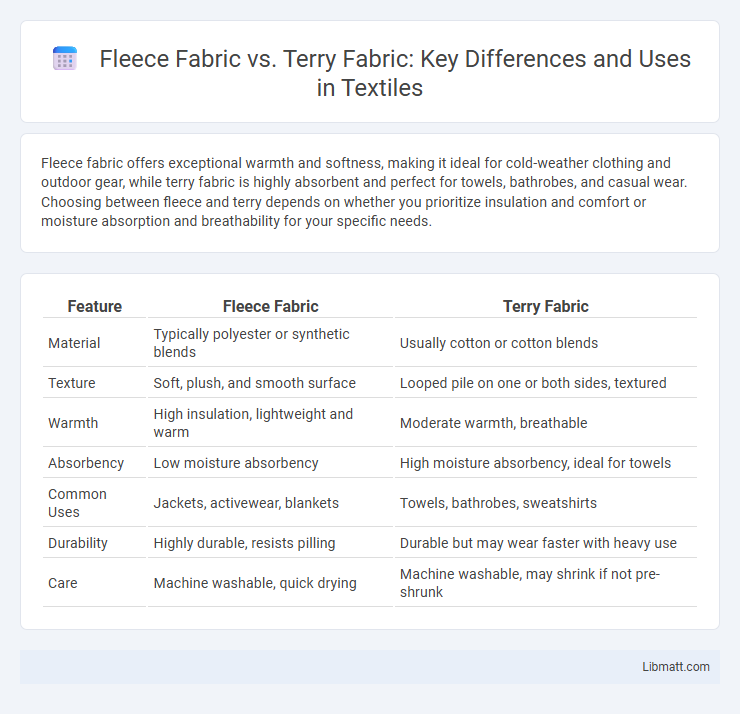Fleece fabric offers exceptional warmth and softness, making it ideal for cold-weather clothing and outdoor gear, while terry fabric is highly absorbent and perfect for towels, bathrobes, and casual wear. Choosing between fleece and terry depends on whether you prioritize insulation and comfort or moisture absorption and breathability for your specific needs.
Table of Comparison
| Feature | Fleece Fabric | Terry Fabric |
|---|---|---|
| Material | Typically polyester or synthetic blends | Usually cotton or cotton blends |
| Texture | Soft, plush, and smooth surface | Looped pile on one or both sides, textured |
| Warmth | High insulation, lightweight and warm | Moderate warmth, breathable |
| Absorbency | Low moisture absorbency | High moisture absorbency, ideal for towels |
| Common Uses | Jackets, activewear, blankets | Towels, bathrobes, sweatshirts |
| Durability | Highly durable, resists pilling | Durable but may wear faster with heavy use |
| Care | Machine washable, quick drying | Machine washable, may shrink if not pre-shrunk |
Introduction to Fleece and Terry Fabrics
Fleece fabric, crafted from synthetic fibers like polyester, offers lightweight warmth and moisture-wicking properties, making it ideal for activewear and casual clothing. Terry fabric, characterized by its looped pile on one or both sides, is traditionally made from cotton and excels in absorbency, commonly used for towels and bathrobes. Both fabrics provide comfort but serve distinct functions based on their fiber content and texture.
Composition and Material Differences
Fleece fabric is primarily made from synthetic fibers such as polyester, providing a soft, lightweight, and insulating material ideal for activewear and cold-weather clothing. Terry fabric, composed mainly of cotton with looped pile on one or both sides, offers superior absorbency and breathability, making it the preferred choice for towels and bathrobes. These composition differences influence their texture, moisture-wicking abilities, and overall use in apparel and home textiles.
Manufacturing Processes Compared
Fleece fabric is typically manufactured through a knitting process followed by brushing to create its soft, fluffy surface, while terry fabric is woven with looped piles on one or both sides, giving it a textured, absorbent quality. The knitting and brushing of fleece involve synthetic fibers such as polyester, enhancing warmth and lightweight softness, whereas terry is often made from cotton, emphasizing durability and moisture absorption. Your choice depends on whether you prioritize plush warmth or absorbency, as these fundamental manufacturing differences directly impact fabric performance and feel.
Texture and Appearance
Fleece fabric features a soft, plush texture with a smooth, velvety surface that offers warmth and comfort, while terry fabric exhibits a looped, absorbent texture ideal for moisture-wicking purposes. The appearance of fleece is typically dense and uniform with a brushed finish, contrasting with terry's rougher, looped surface that gives it a more casual and utilitarian look. Both fabrics are popular in apparel and home textiles, but their distinct textures and appearances cater to different functional needs and aesthetic preferences.
Warmth and Insulation Properties
Fleece fabric offers excellent warmth and insulation due to its synthetic fibers and dense pile structure, trapping heat effectively and wicking moisture away from the skin. Terry fabric provides moderate warmth with its looped cotton fibers, which absorb moisture but do not insulate as efficiently as fleece. Your choice between fleece and terry fabric should consider the level of warmth and breathability required for your activity.
Absorbency and Moisture Management
Fleece fabric excels in moisture management by wicking sweat away from the skin and drying quickly, making it ideal for activewear and outdoor clothing. Terry fabric offers superior absorbency due to its looped pile construction, effectively trapping moisture, which is why it's commonly used in towels and bathrobes. While fleece prioritizes breathability and quick drying, terry fabric's moisture retention makes it better suited for drying and comfort after bathing.
Durability and Longevity
Fleece fabric, made from synthetic fibers like polyester, offers excellent durability due to its resistance to wear, stretching, and shrinking, making it ideal for long-lasting casual and outdoor clothing. Terry fabric, typically crafted from cotton or cotton blends, provides strong durability but can wear down faster with frequent washing and heavy use, especially if made from lower-quality fibers. Both fabrics maintain longevity when cared for properly, but fleece generally outperforms terry in resisting abrasion and maintaining shape over extended periods.
Common Uses and Applications
Fleece fabric is commonly used for activewear, outdoor clothing, and cozy blankets due to its lightweight warmth and moisture-wicking properties. Terry fabric is frequently applied in towels, bathrobes, and sportswear because of its high absorbency and soft texture. Your choice between fleece and terry depends on whether you prioritize insulation or moisture absorption for your project.
Care and Maintenance Tips
Fleece fabric requires gentle washing in cold water with mild detergent to maintain its softness and prevent pilling, and it should be air-dried or tumble dried on low heat to avoid shrinking. Terry fabric demands thorough rinsing after washing to remove detergent residue and benefits from occasional fabric softener to keep the loops plush, with drying best done in a machine on medium heat to preserve absorbency. Your textile care routine should adapt to these specific needs to extend the lifespan and look of both fleece and terry fabrics.
Choosing Between Fleece and Terry Fabric
Choosing between fleece and terry fabric depends on your specific needs for warmth and texture. Fleece offers superior insulation with a soft, plush surface ideal for cold weather, while terry fabric provides excellent moisture absorption and breathability, making it perfect for towels and activewear. Your decision should consider whether you prioritize warmth and softness or absorbency and durability.
Fleece Fabric vs Terry Fabric Infographic

 libmatt.com
libmatt.com